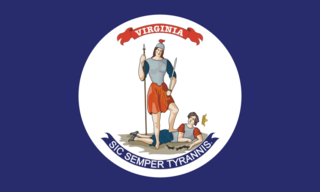
Tallahassee is the capital city of the U.S. state of Florida. It is the county seat and only incorporated municipality in Leon County. Tallahassee became the capital of Florida, then the Florida Territory, in 1824. In 2010, the population was 181,376, making it the 8th-largest city in the U.S state of Florida, and the 126th-largest city in the United States. The population of the Tallahassee metropolitan area was 385,145 as of 2018. Tallahassee is the largest city in the Florida Big Bend and Florida Panhandle region, and the main center for trade and agriculture in the Florida Big Bend and Southwest Georgia regions.

Miccosukee is a small unincorporated community in northeastern Leon County, Florida, United States. It is located at the junction of County Road 59 and County Road 151. Miccosukee was a major center of the Miccosukee tribe, one of the tribes of the developing Seminole nation, during the 18th century.

Francis Wayles Eppes was a planter and slave owner from Virginia who became prominent near and in Tallahassee, Florida. His maternal grandparents were President Thomas Jefferson and his wife Martha; his paternal grandparents were Francis Wayles Eppes VI, also a prominent planter in Virginia, and his wife Elizabeth Wayles, half-sister to Martha Wayles Skelton Jefferson.

The Francis Eppes Plantation was a cotton plantation of 1,920 acres (8 km2) situated in east-central Leon County, Florida, United States and established by Francis W. Eppes in 1829.
The History of Leon County, Florida is a varied history of human habitation extending from 12,000 years ago to present. This includes Paleoindians, the Apalachee, the Seminole Indians, the British, Spanish, colonial Americans, and slaves.

David Lang was a land surveyor, Confederate States Army officer during the American Civil War, civil engineer, and Florida politician.

George Washington Scott was a noted Florida businessman, planter, and military officer in the Confederate States Army during the American Civil War.

Florida participated in the American Civil War as a member of the Confederate States of America. It had been admitted to the United States as a slave state in 1845. In January 1861, Florida became the third Southern state to secede from the Union after the November 1860 presidential election victory of Abraham Lincoln. It was admitted to the breakaway Confederate States of America in April 1861 in advance of the American Civil War.
The history of Tallahassee, like the history of Leon County, begins with the Native American population and its interaction with British and Spanish colonists as well as Anglo-American colonists and Africans escaping colonial slavery, as the Florida Territory moved toward statehood. Growing numbers of cotton plantations increased the settlement's population greatly. It became a city and capital in 1821.

The 1st Florida Cavalry Regiment was a Confederate army unit during the U.S. Civil War, originally organized in July 1861 at Tallahassee. Members of the regiment came primarily from Alachua, Clay, Columbia, Duval, Leon, Levy, Nassau and Suwannee counties. It left for the western theater in 1862.

Camp Leon was a Confederate army encampment during the American Civil War located south of Tallahassee in southern Leon County, Florida, United States near the unincorporated community of Belair. It is the best known of the three camps located in the county.

Camp Lay was a Confederate army encampment during the American Civil War located near Tallahassee in Leon County, Florida, United States. Its exact location is not currently known.

The 12th Virginia Infantry Regiment was an infantry regiment mostly raised in Petersburg, Virginia, for service in the Confederate States Army during the American Civil War, but with units from the cities of Norfolk and Richmond, and Greensville and Brunswick counties in southeastern Virginia. It fought mostly with the Army of Northern Virginia.

The 1st Virginia Cavalry Regiment was a cavalry regiment raised in Virginia for service in the Confederate States Army during the American Civil War. It fought mostly with the Army of Northern Virginia.

Theodore Washington Brevard Jr. was an American military officer best known for having served in the Confederate States Army. During his tenure with the Confederate army, he eventually reached the rank of Brigadier-General. Brevard was captured by the forces of General George Custer and imprisoned at Johnson's Island. He later died in 1882.

The Governor's Guards is a historic unit of the Florida Army National Guard, stationed in Tallahassee, Florida. Its current designation is Troop C, 1st Squadron, 153rd Cavalry. The unit has one of the oldest continuous lineages in the Florida National Guard. In 1857, Captain John Parkhill, his brother Samuel M. Parkhill, and Theordore Brevard, Jr. formed a mounted company of "Leon Volunteers" to fight in the Third Seminole War, where John Parkhill was killed in action. John Parkhill's cousin, Captain George W. Parkhill and his brother, Richard C. Parkhill formed a new company called the "Governor's Guards" circa 1859-1860 which later changed its name to "Howell Guards" and fought with the Second Florida Infantry during the Civil War. After the war, the company reorganized as "Governor's Guards", a local militia company, under the command of Captain Alexander Moseley and have had a near-continuous lineage henceforth. The Governor's Guards served as an infantry unit for most of its existence, including in the Civil War, World War I, World War II, the Iraq War and the Global War on Terrorism. The unit consolidated with the Franklin Guards, a detachment in Apalachicola and since 2007 has been Charlie Troop, a dismounted infantry reconnaissance troop.

The Cathedral Church of St. Luke is an Episcopal cathedral in Orlando, Florida, United States. It is the seat of the Diocese of Central Florida.
Greenwood Cemetery is a historic cemetery located in Orlando, Florida.

The Mayor of Tallahassee is head of the executive branch of the government of Tallahassee, Florida.
The Franklin Guards was a unit of the Florida Army National Guard, stationed in Apalachicola. The company was founded in 1836 by Captain Abraham K. Allison as the Franklin Volunteers and fought in the Second Seminole War under General Richard K. Call's battalion of volunteers. The Territorial Legislature incorporated the company as the "Apalachicola Guards" on March 14, 1843. This act formalized their relationship with the territorial governor and afforded them territory-funded arms and equipment. During the American Civil War, the Apalachicola Guards mustered into service as Company B, First Florida on April 5, 1861. After the war, the company reorganized as Franklin Guards, under the command of Captain Robert Knickmeyer and Lieutenant William Orman. The Guards served as an infantry unit for most of their existence, including in the Civil War and World War I. The Guards had reorganized into an engineer company after World War I and deployed as such to the Pacific Theatre with the 31st Infantry Division in World War II. After the end of World War II, the company became an artillery and then infantry company of the 124th Infantry. It served with that unit until 1963, when it became part of the 261st Engineer Battalion as an armored engineer company. In 1968 it was reorganized into two platoons of Company C of the 3rd Battalion, 124th Infantry, and two years later became Detachment 1 of the company. After transferring to Company A in 1998, it consolidated with the company in 2007 to become Troop C, 1st Squadron, 153rd Cavalry.













